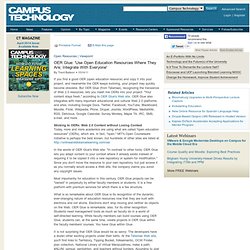

OER Glue: "Use Open Education Resources Where They Are; Integrate With Everyone" Open Resources | Viewpoint OER Glue: 'Use Open Education Resources Where They Are; Integrate With Everyone' By Trent Batson05/04/11 If you find a good OER (open education resource) and copy it into your project, and meanwhile the OER keeps evolving, your project may quickly become obsolete.

But OER Glue (from Tatemae), recognizing the transience of Web 2.0 resources, lets you mash live OERs into your project. "Your content stays fresh," according to OER Glue's Web site. Pelc 2010 ugc final. (Non)Profit sharing for OpenCourseWare? « OpenFiction [Blog] As we’ve been working through the possible business models to sustain OpenCourseWare, we’ve come across revenue opportunities that can be broadly divided into two categories—opportunities that depend on the site as a whole, and opportunities that meaningfully depend on content from individual course content.
![(Non)Profit sharing for OpenCourseWare? « OpenFiction [Blog]](http://cdn.pearltrees.com/s/pic/th/opencourseware-openfiction-16261180)
There is some blurring between the two, as will be clear below, but it is a useful distinction nonetheless. At the outset, too, I want to say that I am only discussing opportunities that are consistent with the mission and spirit of OCW, i.e. don’t charge end users for access to content. There are plenty of opportunities that do charge end users for access to content, but those are best left to the faculty to negotiate directly with the other interested party. I’m imagining it might be possible to enlist faculty in an OCW development cooperative that would exist primarily to secure funding to support OCW, and secondarily to generate revenue share for participating faculty.
Learning Design for Open Educational Resources. Learning design is an approach that considers learning materials as having both a final product, the educational resource, and a design that captures the intent of the product.

This design is often implicit and has not been valued as a product in itself. OER challenge that position as it becomes important to communicate why material has been developed so that users can make best use of the material and also see the designs as shareable in themselves. Designs matter both to educators, to understand potential reuse, and to users to help them select material relevant to their context.
Two related aspects are whether representing the design explicitly will help users interpret OER, and whether promoting particular designs (or patterns) will encourage different ways to use OER.